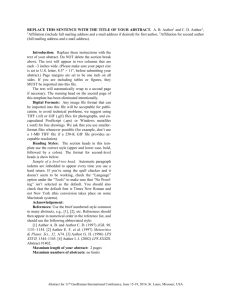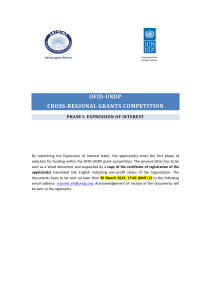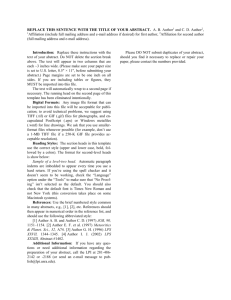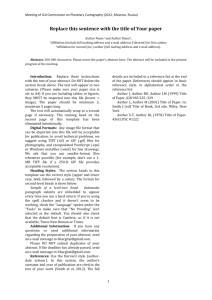Possible funding sources for projects
advertisement
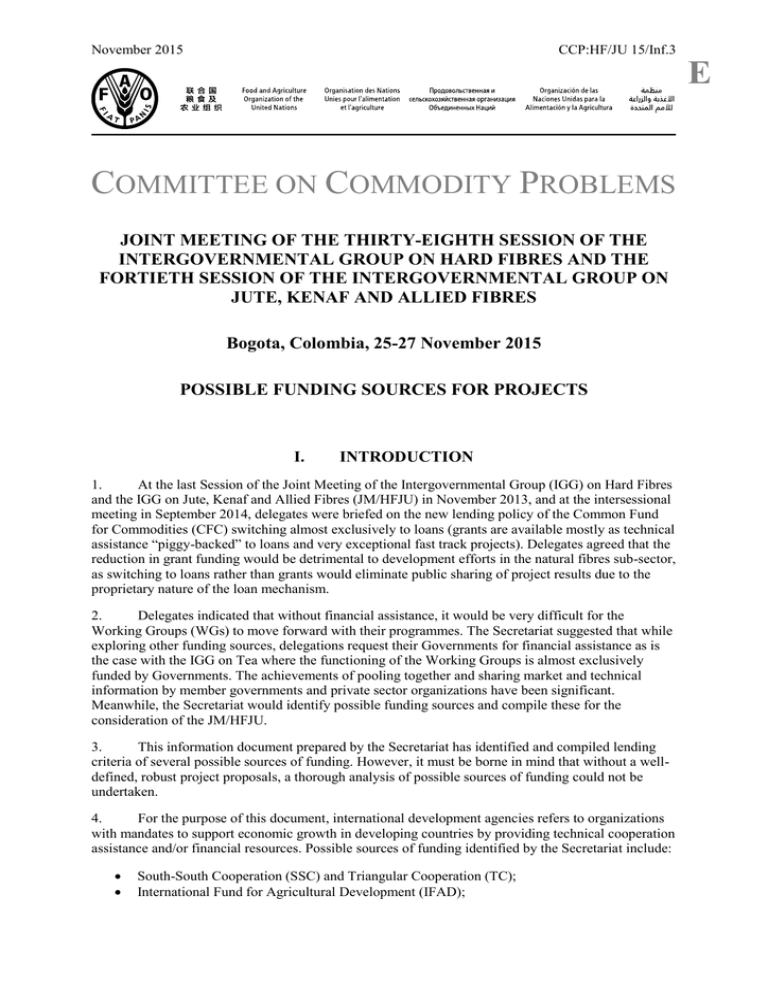
November 2015 CCP:HF/JU 15/Inf.3 E COMMITTEE ON COMMODITY PROBLEMS JOINT MEETING OF THE THIRTY-EIGHTH SESSION OF THE INTERGOVERNMENTAL GROUP ON HARD FIBRES AND THE FORTIETH SESSION OF THE INTERGOVERNMENTAL GROUP ON JUTE, KENAF AND ALLIED FIBRES Bogota, Colombia, 25-27 November 2015 POSSIBLE FUNDING SOURCES FOR PROJECTS I. INTRODUCTION 1. At the last Session of the Joint Meeting of the Intergovernmental Group (IGG) on Hard Fibres and the IGG on Jute, Kenaf and Allied Fibres (JM/HFJU) in November 2013, and at the intersessional meeting in September 2014, delegates were briefed on the new lending policy of the Common Fund for Commodities (CFC) switching almost exclusively to loans (grants are available mostly as technical assistance “piggy-backed” to loans and very exceptional fast track projects). Delegates agreed that the reduction in grant funding would be detrimental to development efforts in the natural fibres sub-sector, as switching to loans rather than grants would eliminate public sharing of project results due to the proprietary nature of the loan mechanism. 2. Delegates indicated that without financial assistance, it would be very difficult for the Working Groups (WGs) to move forward with their programmes. The Secretariat suggested that while exploring other funding sources, delegations request their Governments for financial assistance as is the case with the IGG on Tea where the functioning of the Working Groups is almost exclusively funded by Governments. The achievements of pooling together and sharing market and technical information by member governments and private sector organizations have been significant. Meanwhile, the Secretariat would identify possible funding sources and compile these for the consideration of the JM/HFJU. 3. This information document prepared by the Secretariat has identified and compiled lending criteria of several possible sources of funding. However, it must be borne in mind that without a welldefined, robust project proposals, a thorough analysis of possible sources of funding could not be undertaken. 4. For the purpose of this document, international development agencies refers to organizations with mandates to support economic growth in developing countries by providing technical cooperation assistance and/or financial resources. Possible sources of funding identified by the Secretariat include: South-South Cooperation (SSC) and Triangular Cooperation (TC); International Fund for Agricultural Development (IFAD); 2 CCP:HF/JU 15/Inf.3 United States Aid for International Development (USAID); United Kingdom Department for International Development (DFID); Global Innovation Fund (GIF); The OPEC Fund for International Development (OFID); Swedish International Development Cooperation (SIDA); and German Society for International Cooperation (GIZ) GmbH. 5. These possible sources of funding focus on projects at the country level. Therefore, delegates should note that applications for funding of strong project proposals would have to be submitted to these institutions through their governments. II. A. POSSIBLE FINANCING SOURCES SOUTH-SOUTH COOPERATION AND TRIANGULAR COOPERATION STRATEGIES 6. SSC is based on mutual sharing of knowledge, experience and good practices, policies, technology and resources among developing countries in the global South. TC comprises of partnerships between at least two developing countries and a third partner which usually is a traditional resource partner and/or a multilateral organization. The SSC and TC programmes that FAO facilitates provide support to developing countries. 7. The role that FAO plays in SSC and TC focuses on four pillars: 1) Providing upstream policy support by: Giving policy advice and support to member countries; Bringing parties together and facilitating policy discussions and sharing among policy makers. 2) Promoting knowledge network platforms by: Identifying, promoting and strengthening knowledge platforms; Developing and maintaining rosters of experts, institutions and good practices; and Linking educational and knowledge institutions with operations institutions. 3) Facilitating the exchange of development solutions by: Deploying experts who share development solutions, capacities, best practices, etc. and inter alia provide technical advice; Exchanging best practices and sharing of expertise through study tours, courses, workshops, etc.; Capacity building; and Exchanging in-kind support and technological solutions. 4) Fostering an enabling environment for effective SSC by reinforcing the above technical pillars through inter alia building broader partnerships and strategic alliances, monitoring and evaluation, resource mobilization and increasing visibility. B. 8. INTERNATIONAL FUND FOR AGRICULTURAL DEVELOPMENT (IFAD) The overarching goal of IFAD is underpinned by five strategic objectives, namely: 1) A natural resource and economic asset base for poor rural women and men that is more resilient to climate change, environmental degradation and market transformation; CCP:HF/JU 15/Inf.3 3 2) Access for poor rural women and men to services to reduce poverty, improve nutrition, raise incomes and build resilience in a changing environment; 3) Poor rural women and men and their organizations able to manage profitable, sustainable and resilient farm and non-farm enterprises or take advantage of decent work opportunities; 4) Poor rural women and men and their organizations able to influence policies and institutions that affect their livelihoods; and 5) Enabling institutional and policy environments to support agricultural production and the full range of related non-farm activities. 9. The project design process typically involves the following sequence of activities: 1) Project concept note will initially be elaborated as part of the Countries Strategic Opportunities Programme (COSOP), establishing the framework for project processing. The key principles in completing a COSOP Results Management Framework include1: Accountability: the COSOP needs to be a tool that enable monitoring and evaluation of the progress in meeting the objectives, including outcomes and milestones over a five-year period; Baselines establishing the starting point for each COSOP; Selection of strategic objectives, outcomes and milestones; Quantification of indicators; and Annual reporting. 2) Detailed project design and quality enhancement will be reflected in a project design report (PDR). The PDR will cover: Strategic context and rationale for IFAD's involvement, commitment and partnership; Poverty, social capital and targeting; Project description; Implementation and institutional arrangements; Project benefits, costs and financing; Project risks and sustainability; and Innovative features, learning and knowledge management. 3) Design completion and quality assurance. Once the PDR has reached its design completion point, the final step in the process will be independent quality assurance. Following a satisfactory review of the final PDR, the President's Report and the draft loan agreement are finalized. 4) Negotiation and approval. 5) Implementation starts once the borrower has fulfilled specified conditions allowing IFAD to declare the loan or grant effective. IFAD-financed projects are implemented by national staff with support and guidance from IFAD staff at headquarters and in the country, as applicable. 10. During the period 1 July – 31 December 2015, the interest rate applied for loans (in accordance with the re-calculation of this semester) is 1.16 percent and the interest rate for intermediate loans is the half of the reference rate. 1 Further information on COSOP at: http://www.ifad.org/operations/policy/cosop/guidelines/sourcebook/cosop.pdf. 4 CCP:HF/JU 15/Inf.3 C. UNITED STATES AGENCY FOR INTERNATIONAL DEVELOPMENT 11. USAID is a federally funded development agency of the United States which aims to advance the political and economic interests of the United States through its programmes, using US products and services. USAID works worldwide to democratize the development process by involving people in the decisions made about their countries and communities for greater sustainability. USAID work areas are: Democracy; Economic growth; Education and training; Environmental sustainability; Humanitarian assistance; Information technology; and Population, health and nutrition. 12. To ensure that agricultural investments are sustainable and country-led, USAID supports agricultural capacity development on farms and in the private sector, producer organizations, research and extension institutions, government agencies, rural financial institutions and civil society. 13. The new agricultural research portfolio focuses on three major areas to meet global food security goals: Advancing productivity by supporting research to reduce production constraints, increasing yield potentials for major crops and livestock through both traditional breeding and biotechnology, and improving management practices for aquaculture and fisheries; Transforming key production systems through sustainable intensification in areas where poverty and mal and undernutrition are concentrated. Specifically, the sustainable intensification approach works on integrating advances in soil fertility, agronomy, animal science, water management, market access, policies, and nutrition; and Improving food safety and nutrition by enhancing dietary diversity, understanding household decision-making, improving access to and availability of nutritious foods, and reducing postharvest losses and contamination. D. UNITED KINGDOM DEPARTMENT FOR INTERNATIONAL DEVELOPMENT 14. DFID is a United Kingdom Government department responsible “to promote sustainable development and eliminate world poverty”. 15. The DFID Impact Fund is focused on investments in low income and lower-middle income countries in sub-Saharan Africa and South Asia, with a maximum of 15 percent of capital available for investing in India through a regional or a global intermediary. DFID’s partners are Afghanistan, Bangladesh, Burma, Democratic Republic of Congo, Ethiopia, Ghana, India, Kenya, Kyrgyzstan, Liberia, Malawi, Mozambique, Nepal, Nigeria, Pakistan, Rwanda, Sierra Leone, Somalia, South Africa, Sudan, South Sudan, Tajikistan, Tanzania, Uganda, Yemen, Zambia and Zimbabwe. 16. The DFID Impact Fund is invested through vehicles that have a clear strategy to invest in businesses that achieve positive impact on the BoP (bottom of the pyramid) population in their target geographies as consumers, producers or workers. Funds which have a potential to invest in sectors or enterprises that target poor women and girls as suppliers, producers or consumers of essential goods or businesses for the poor in post-conflict countries are particularly welcome to apply for aid. 17. The Fund seeks to invest in the region of £5m to £15m per investment and to be a catalyst for attracting private investment. The larger the proportion of investment, the greater the chance of the proposal being successful. While the investment universe includes all countries in Africa and South CCP:HF/JU 15/Inf.3 5 Asia, the organization strongly encourages proposals that focus on making investments in low income countries deliver higher impact projects. The Fund normally seeks co-financiers, unless there is a clear rationale why other investors cannot be brought in. A small proportion of the Fund’s investment can be used to cover first losses of private investors if this would encourage them to invest in high development impact projects. However, these first-loss guarantees are not available to leverage coinvestment from other public investors (such as development finance institutions or multilateral and bilateral aid agencies). The Fund supports investments with up to a maximum of a ten-year term. E. GLOBAL INNOVATION FUND 18. The GIF is a new non-profit organization headquartered in London, which invests in social innovations that improve the lives and opportunities of people in the developing world. GIF is open to funding a wide range of innovative organisations and projects at varying stages in their development, ranging from early start-up stages to larger scale implementation. Borrowing from the experience of venture capital, GIF uses a tiered financing model and offers three stages of funding. GIF offers grants, loans (including convertible debt) and equity investments ranging from USD 50 000 to USD 15 million. They invest in a range of social innovations in developing countries. Their tiered financing model offers three stages of funding: Pilot Stage (up to USD 230 000) to support start-up and field-testing of innovations; Test and Transition (up to USD 2.3 million). This stage is for innovators who require support for continued growth and for assessing the likelihood that the innovation can achieve social impact; and Scaling up (up to USD 15 million) where GIF supports the expansion of innovations that have already demonstrated a strong track record of social impact and effectiveness. 19. GIF seeks to build a diverse roster of reviewers with expert technical knowledge to provide brief reviews of shortlisted funding proposals. Comments and feedback from GIF’s expert reviewers are considered very carefully during the final stages of GIF’s investment decisions. 20. GIF contact reviewers as needed with opportunities to provide feedback on shortlisted proposals that are relevant to the reviewer’s areas of expertise. They score applications in accordance with their review protocols. For each review opportunity they accept, reviewers must commit to a specified timeframe for completion, usually one-two weeks. GIF reviewers are not required to commit to reviewing a minimum number of proposals. F. THE OPEC FUND FOR INTERNATIONAL DEVELOPMENT (OFID) 21. OFID is the development finance institution established by the Member States of OPEC in 1976 as a collective channel of aid to the developing countries. OFID works in cooperation with developing country partners and the international donor community to stimulate economic growth and alleviate poverty in disadvantaged regions around the world. It achieves this by providing financing to build essential infrastructure, strengthen social services delivery and promote productivity, competitiveness and trade. The focus areas of OFID are inter alia: Energy; Transportation; Water supply and sanitation; Telecommunications; Health; Education; Agriculture; Industry; 6 CCP:HF/JU 15/Inf.3 Financial; and Infrastructure and mining. 22. OFID focuses on projects that meet basic needs with the aim of encouraging self-reliance and inspiring hope for the future. At the end of 2014, OFID’s cumulative support to agriculture stood at USD 2 354.9 million, or 14 percent of total approvals. These resources have supported various aspects of the value chain, from crop and livestock production and artisanal fisheries, to agro-processing, marketing, trade and financial services. OFID also supports the sector by promoting agricultural research and improving rural infrastructure. 23. Those eligible for OFID assistance are international, national, regional and non-governmental organizations that supply proof of their financial and legal status. Individuals, private entities and OFID Member States2 are not eligible to receive grant assistance. High priority is given to initiatives that benefit low-income, least-developed countries. All OFID assistance is earmarked to contribute to socio-economic progress in a receptive country. G. SWEDISH INTERNATIONAL DEVELOPMENT COOPERATION (SIDA) 24. SIDA is a government agency that operates on behalf of the Swedish Government. Its mission is inter alia to reduce poverty and to distribute humanitarian aid to those in need by creating income opportunities and strengthening democracy, among others. SIDA allocates aid and other funding, and their operations are managed through Government guidelines3, where a description of the goals for each year’s operations and the size of the development aid budget are found. SIDA provides the Government with assessments and information required to decide and implement its development assistance policy. 25. SIDA cooperates with various organizations, associations, agencies, companies and cooperatives, such as civil society organizations, the private and public sectors and research cooperation institutions. 26. SIDA supports various challenge funds to encourage innovations in development cooperation. Challenge funds are a financing mechanism where donors use competition to find solutions to development problems in specific areas, such: Innovations Against Poverty (IAP); Global Innovation Fund (GIF); Making All Voices Count, which focuses on strengthening democracy through information and communication technology; Securing Water for Food; Powering Agriculture; African Enterprise Challenge Fund (AECF); and Seed Alliance. 27. Small- and medium-sized enterprises, organizations, institutions and individuals compete by submitting their project proposals to the specific challenge fund. The successful proposals are supported financially, and in many cases Sida provides advice to enable further development and scale-up of products or methods. Financing from the challenge fund usually must be matched by a percentage of self-funding. 2 Algeria, Ecuador, Gabon, Indonesia, Iraq, Islamic Republic of Iran, Kuwait, Libya, Nigeria, Qatar, Saudi Arabia, United Arab Emirates, Venezuela. 3 For more information on the Government guidelines, please go to: http:&&www.sida.se/English/Aboutus/How-we-are-governed/. CCP:HF/JU 15/Inf.3 7 28. The periods of submission to the challenge funds vary. For more information and updates, please see http://www.sida.se/English/partners/resources-for-all-partners/Calls-and-announcements/. H. DEUTSCHE GESELLSCHAFT FÜR INTERNATIONALE ZUSAMMENARBEIT (GIZ) GmbH4 29. Specializing in international cooperation for sustainable development, the federally-owned GIZ supports the Government of Germany in reaching its policy objectives on development. They support federal ministries and other public institutions in the following areas: economic development and employment; government, democracy and poverty reduction; education, health and social security; environment and infrastructure; and agriculture, fisheries and food. Its services include: managing complex processes, technical consultancies, education and training and procurement and funding management. GIZ provides these services by designing and managing major projects; planning and managing national and international programmes; managing multi-stakeholder processes; and pooling specialists with technical, regional and management competencies. 30. GIZ operates mostly on behalf of the Federal Ministry for Economic Cooperation and Development. It also works with other donors such as the European Union, the World Bank and the United Nations and partner countries. GIZ increasingly cooperates with the private sector through International Services and Public-Private Partnerships. They provide export support on applications to EU grant programmes. 4 German Society for International Cooperation (GIZ) GmbH.

